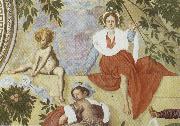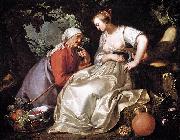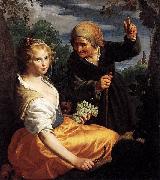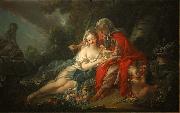
|
Pontormo
|
|||
|
|
|||
| Italian Mannerist Painter, 1494-ca.1556 | |||
|
|
|||
|
Vertumnus y Pomona new9/Pontormo-864677.jpg Pintura Identificación:: 33241 |
mk83 1519-1521 | ||
|
|
|||
|
Pontormo, Jacopo
|
|||
|
|
|||
|
|
|||
|
Vertumnus and Pomona new16/Pontormo, Jacopo-777675.jpg Pintura Identificación:: 43595 |
461 x 990 cm | ||
|
|
|||
|
Abraham Bloemaert
|
|||
|
|
|||
| (1566, Gorinchem - 27 January 1651, Utrecht), was a Dutch painter and printmaker in etching and engraving. He was one of the "Haarlem Mannerists" from about 1585, but in the new century altered his style to fit new Baroque trends. Bloemaert was the son of an architect, who moved his family to Utrecht in 1575, where Abraham was first a pupil of Gerrit Splinter (pupil of Frans Floris) and of Joos de Beer. He then spent three years in Paris, studying under several masters, and on his return to his native country received further training from Hieronymus Francken. In 1591 he went to Amsterdam, and four years later settled finally at Utrecht, where he became dean of the Guild of St. Luke. He excelled more as a colourist than as a draughtsman, was extremely productive, and painted and etched historical and allegorical pictures, landscapes, still-life, animal pictures and flower pieces. In the first decade of the seventeenth-century, Bloemaert began formulating his landscape paintings to include pictoresque ruined cottagges and other pastoral elements. In these works, the religious or mythological figures play a subordinate role. Country life was to remain Bloemaert's favourite subject, which he depicted with increasing naturalism. He drew motifs such as peasant cottages, dovecotes and trees from life and then on his return to the studio, worked them up into complex imaginary scenes. Among his pupils are his four sons, Hendrick, Frederick, Cornelis, and Adriaan (all of whom achieved considerable reputation as painters or engravers), the two Honthorsts, Ferdinand Bol and Jacob Gerritsz Cuyp. | |||
|
|
|||
|
Vertumnus and Pomona new23/Abraham Bloemaert-848835.jpg Pintura Identificación:: 71422 |
Date 1620 Medium Oil on canvas Dimensions 98 x 125 cm (38.58 x 49.21 in) | ||
|
|
|||
|
Paulus Moreelse
|
|||
|
|
|||
| (1571, Utrecht - 6 March 1638, Utrecht) was a Dutch painter, mainly of portraits. Moreelse was a pupil of the Delft portrait painter Michiel Jansz. van Mierevelt, who had himself been a pupil of Anthonie van Blocklandt. He took a study-trip to Italy, where he received many portrait commissions. Back in Utrecht, in 1596 he became a member of the zadelaarsgilde, which was the traditional name in Utrecht for the Guild of Saint Luke. In 1611, along with Abraham Bloemaert, he was one of the founders of a new painters' guild, called "St. Lucas-gilde", and became its first deken. Moreelse was a well known portrait painter who received commissions from right across the Dutch Republic. His earliest work dates to 1606. Other than portraits, he also painted a few history paintings in the Mannerist style and in the 1620s produced pastoral scenes of herders and shepherds. He belonged to the same generation as Abraham Bloemaert and Joachim Wtewael, and like Wtewael he played an important role in the public life of their city. His version of Diana and Callisto was engraved by Jan Saenredam. In 1618, when the anti-remonstrants came to power in Utrecht, he was raadslid. | |||
|
|
|||
|
Vertumnus and Pomona new24/Paulus Moreelse-797847.jpg Pintura Identificación:: 83755 |
Date ca. 1630 (1586 - 1638) Medium Oil on canvas Dimensions 130 x 114 cm (51.2 x 44.9 in) cjr | ||
|
|
|||
|
Francois Boucher
|
|||
|
|
|||
| French Rococo Era Painter, 1703-1770 | |||
|
|
|||
|
Vertumnus and Pomona new25/Francois Boucher-484776.jpg Pintura Identificación:: 85955 |
1749(1749) Medium Oil on canvas cyf | ||
|
|
|||
|
Also Buy::. For Following Paintings / Artists / Products, Please Use Our Search Online: |










